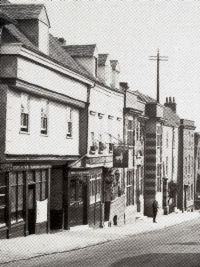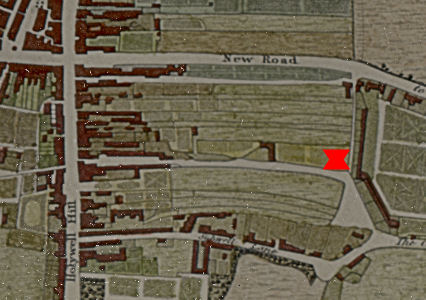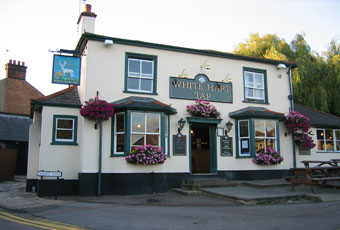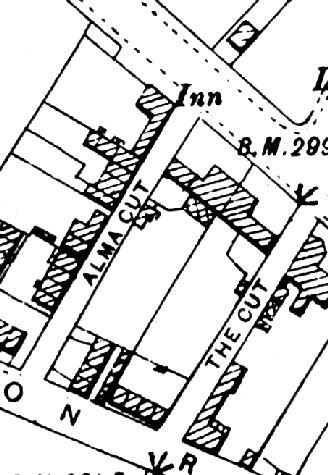|
|
The White Hart Tap and the Eagle & Child, St Albans, 19th Century |
|
|
|
The White Hart Tap and the Eagle & Child, St Albans, 19th Century |
|
Mary Hider (mhider21 @t aol.com) of Leicester writes: I'm trying to use web sources to add to the research my father Leslie (1910-2004) did in the 1970s. His grandfather Edwin Francis Lewis appeared to be the illegitimate child of Mary Lewis. My father was orphaned and brought up by 'Aunt' Lizzie Catharine Skinner (b. 29.10.1860 at the White Hart Tap, the daughter of Caroline Skinner (nee Lewis) and George Skinner. Caroline might have been Mary's sister, but I've not found Mary on any census data. Your Genealogy site has a list of publicans, intriguingly a George Skinner was publican of the Eagle and Child, London Rd, c. 1882. Her father might have become a publican, though in 1860 he was a hat blocker but Caroline also had a younger brother George. I can't find any historical references to the Eagle and Child; obviously in the vicinity of the White Hart Tap - could it be a previous name for that pub. None of the London Road addresses on the 1881 census have the Eagle and Child, nor Skinners, nor have I any results for White Hart Tap without a street name. I imagine Keyfield, Pageant Rd, Hart Rd were not built then - as a child my father lived in Hart Rd in a house named Lesvic after him.
Some of the memorabilia he kept about St. Albans I've just given to the museum.
|
I have divided this question into two parts. This part deals with The White Hart Tap and Child & Eagle, and the other part deals with Lewis & Stringer genealogy. |
 |
|
|
The White Hart in 1921 |
|
|
Detail from Collectorcard reprint |
In order to understand the history of these two properties it is important to understand how the town of St Albans changes in the early 19th century. For perhaps a thousand years traffic from London going north through St Albans entered along Sopwell Lane and up Holywell Hill to pass by the Abbey. On either side of Holywell Hill there were inns to cater for the passing travellers. Those on the west had small plots because they backed onto the Abbey grounds, but those on the east had extremely long and narrow plots which ran from the road to Tonmans Ditch, which marked the boundary of the old Saxon town. Over the centuries the road layout remained unchanged but the yards behind the inns were developed to provide facilities for travellers - with stables, etc. One of these inns was the White Hart, and a map of the town in Chauncy (published 1700) shows a side road from Sopwell Lane which almost certainly connected to the rear (eastern end) of White Hart Yard, with access along what would now be called Pageant Road.
 |
|
|
Holywell Hill, Sopwell Lane and the New Road in 1823 |
|
|
Clutterbuck's The History of the County of Hertford |
In the 18th century the coming of turnpike (toll) roads made travelling much easier and the age of the stagecoach (as now remembered) was born. However Holywell Hill is very steep and would have been a real bottleneck. As a result a New Road (the current London Road) was constructed in 1794, bypassing Holywell Hill. (In 1826 Verulam Road was built bypassing Fishpool Street,) This change would have speeded traffic and helped the inns around the Market Place, but the inns in Holywell Hill would have lost some of the passing traffic.
The White Hart Tap
The building of the New Road led to developments outside the old town boundary - and what better way to exploit the changes than to build an additional sales outlet for draught beer at the east end of the White Hart land (X on map) with access to both the old road (Sopwell Lane), to the New London Road, and to the new property developments to the east. The book Hertfordshire Inns & Public Houses records:
 |
|
|
The White House Tap in 2009 |
|
|
[from online advert] |
The deeds in which the house is first mentioned date from 1836 although there is no specific reference to it being licensed until 1841, when it is described on the deeds as a beer house called the White Hart Tap. The land clearly always belonged to the owners of the White Hart on Holywell Hill and the Tap was undoubtedly founded by them. The first recorded licensee was Ann Edmuns who kept it in 1854. At the turn of the 20th century it was considered a rough house by the licensing magistrates.
In trying to unravel its history the fact that it was only a beer house (it provided draught beer on tap) meant that it is rarely mentioned by name in trade directories - unlike public houses with a full licence. Its location also means that in earlier censuses it might be listed with Sopwell Lane, the White Hart Yard (in Holywell Hill) and the New London Road!
 |
|
|
Herts Advertiser, 1st October 1859 |
The 1841 census lists several beer retailers in Sopwell Lane, and it is not certain which (if any) was the White Hart Tap.
In the 1851 census William Edmond is listed as a publican in Sopwell Lane, and the household includes his wife Ann, who was presumably the Ann Edmuns who held the licence of the White Hart Tap in 1854. Mrs Ann Edmunds is listed as a beer retailer at Keyfield Terrace in the 1855 Post Office Directory.
In 1859 the landlord, George Skinner, was prosecuted for serving beer out of hours. Lizzie Catharine Skinner, the daughter of Caroline Skinner (nee Lewis) and George Skinner, was born on 29th October 1860 at the White Hart Tap.
By the time of the 1861 census George Skinner had moved out (see below) and William Dolling was listed as a baker and retailer of beer at the White Hart Tap (which was listed as part of the White Hart Yard off Holywell Hill). Dank's 1863 Directory records William Dolling as a beer retailer of White Hart ride. In the following censuses there was a different publican every year - and no listings in the Kelly's directories I have examined:
1871 William Smith was publican of the White Hart Tap, which was listed as close to the (newly built) Albert Road.
1881 Frederick Holder was a bricklayer at the White Hart Tap, Watsons Row.
1891 Charles L Paul was a publican at the White Hart Tap, listed as part of Albert Street.
1901 Mary Ann Hill was the beer retailer at The White Hart Tap, her husband Alfred Hill was a Shoe Factory Hand.
The Eagle & Child (and The Alma)
Tracing the long established licences public houses by name is often quite easy, but this is not the case of small "new" beer houses and common lodging houses - where the establishment name is often not recorded. This is very much the case for the "Eagle & Child" and the search is much helped because a similar establishment "The Alma" was next door. I list the records I have found so far - more information should be available from the collection of Town Directories in the St Albans Central Library, particularly for the period 1880-1900. Unless otherwise stated all the following relate to the (New) London Road.
1861 Census: Thomas Field is listed as a publican, with ten lodgers, Next door were George Skinner, a blocker of hats, his wife Caroline, and family. Shortly before this George had been publican at the White Hart Tap.
1863 (Dank's Directory): Thomas Field, beer retailer.
1866 (Post Office Directory): Thomas Field, Alma; George Skinner, beer retailer
1870 (Post Office Directory): Thomas Field, Alma
1871 Census: John Kingham, licensed victualler, The Alma, with two lodgers. Next door George Skinner, blocker & publican, Eagle & Child.
1881 Census: John Kingham, licensed victualler with no lodgers - Next door were George and Caroline Skinner and while George is described as straw hat blocker the household included three lodgers - suggesting they may have been running a common lodging house. [Note that the name Skinner is written so badly it is asking to be mis-indexed!]
1882 (Kelly's Herts Directory): John Kingham, Alma; George Skinner, Eagle & Child.
1884 (St Albans Pub Song): Both the Alma and the Eagle & Child are mentioned - This is the last contemporary mention I have of the Eagle & Child. One of the publicans attending the dinner at which the song was introduced was Atkins - so possibly Frederick Atkins had moved to the Alma by this date.
1886 (Kelly's Herts Directory): Frederick Atkins, Alma.
1888 Brewers in Hertfordshire: It would appear that the Alma had been a tied house with the Kingsbury Brewery and was transferred to Bingham Cox and renamed the Great Northern.
1890 (Kelly's Herts Directory): Frederick Atkins, Alma.
1891 Census: Fredrick Atkins, publican, with two lodgers. Next door is Robert Nicholl. with four lodgers, presumably the Eagle & Child - although the trading name Robert used is not recoded.. George Skinner was a hat blocker living in Thorpe Road.
1895 (Kelly's Herts Directory): Frederick Atkins, Great Northern Inn. [Neither Alma or Eagle & Child listed in this or subsequent years].
 1897
(OS Maps): Inn [Great
Northern Inn] marked at (New)
London Road end of the Alma Cut.
1897
(OS Maps): Inn [Great
Northern Inn] marked at (New)
London Road end of the Alma Cut.
1899 (Kelly's Herts Directory): Amos Belton, Great Northern Inn
1901 Census: Frederick Shane was publican of the Great Northern Inn, London Road, adjacent to the Alma Cut. There was no adjacent property which could be identified as the Eagle & Child.
1902 (Kelly's Herts Directory): Frederick Shane, Great Northern Inn. For the subsequent history, including a 2008 picture, see Great Northern Inn.
1920 Brewers in Hertfordshire: It would appear that the Eagle & Child had sold Pryor Reid & Co beer and was closed or transferred prior to 1920 (possibly many years before).
The evidence suggests that between 1861 and 1891 there were neighbouring establishments in London Road which both served alcoholic beverages and/or took lodgers. The more significant was called The Alma and the landlords were Thomas Field, John Kingham and Frederick Atkins. In 1888 it changed brewery and was renamed the Great Northern Inn. The other was the Eagle & Child, landlords were George Skinner and possibly Robert Nicholl, who may have been in the same building, but may not have used the name.
Mary Hider commented: The proximity of the Eagle & Child explains why I'm sure my father used to point out The Alma, though I probably just thought he'd had a pint there if he met me at the station! He had found the poem about the pubs because that was the only reference he found to Poundfield (his grandfather's birthplace), which I've now read about on your site [Pound Field, St Michaels, St Albans, 19th Century]. I've subscribed to an ancestry site to be more thorough with the census data (yes, full of very bad yet funny transcriptions - one poor girl I read was a 'brickmaker' was a brushmaker!)
As I still haven't linked Mary Lewis to Caroline Lewis, George Skinner might not be related, so is not confirmed as the first criminal in my background! I'm surprised that in 1859 two policemen are looking through windows after midnight - and we think ours is a surveillance society ...
Page created January 2010